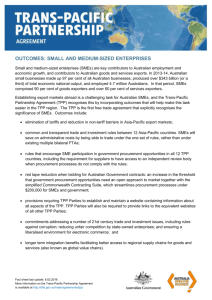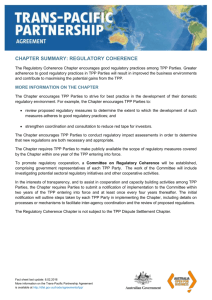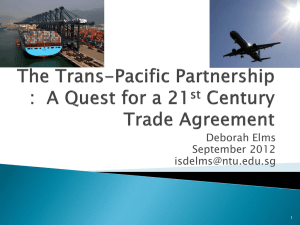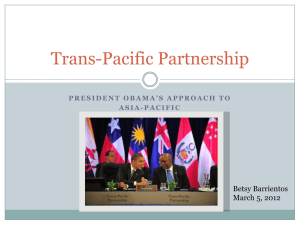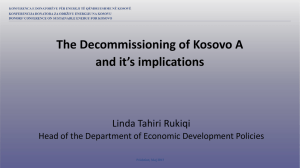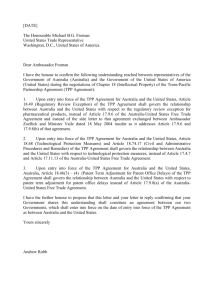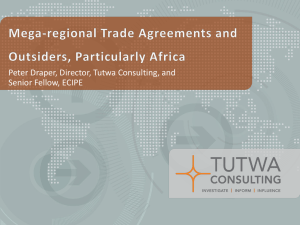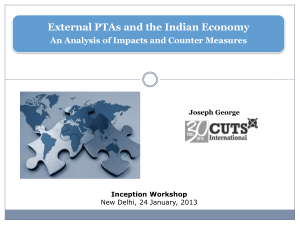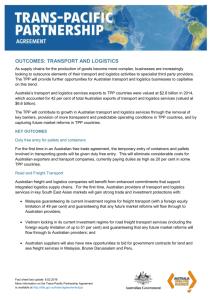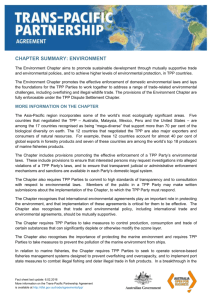Issues covered by the TPP - Department of Foreign Affairs and Trade
advertisement
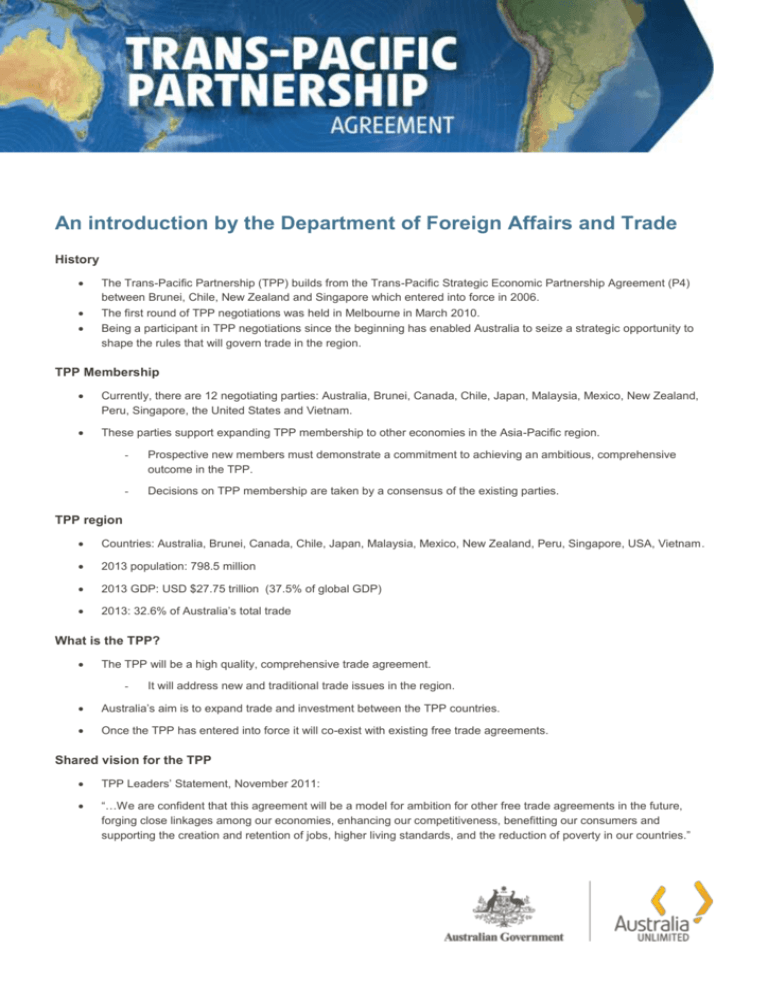
An introduction by the Department of Foreign Affairs and Trade History The Trans-Pacific Partnership (TPP) builds from the Trans-Pacific Strategic Economic Partnership Agreement (P4) between Brunei, Chile, New Zealand and Singapore which entered into force in 2006. The first round of TPP negotiations was held in Melbourne in March 2010. Being a participant in TPP negotiations since the beginning has enabled Australia to seize a strategic opportunity to shape the rules that will govern trade in the region. TPP Membership Currently, there are 12 negotiating parties: Australia, Brunei, Canada, Chile, Japan, Malaysia, Mexico, New Zealand, Peru, Singapore, the United States and Vietnam. These parties support expanding TPP membership to other economies in the Asia-Pacific region. - Prospective new members must demonstrate a commitment to achieving an ambitious, comprehensive outcome in the TPP. - Decisions on TPP membership are taken by a consensus of the existing parties. TPP region Countries: Australia, Brunei, Canada, Chile, Japan, Malaysia, Mexico, New Zealand, Peru, Singapore, USA, Vietnam. 2013 population: 798.5 million 2013 GDP: USD $27.75 trillion (37.5% of global GDP) 2013: 32.6% of Australia’s total trade What is the TPP? The TPP will be a high quality, comprehensive trade agreement. - It will address new and traditional trade issues in the region. Australia’s aim is to expand trade and investment between the TPP countries. Once the TPP has entered into force it will co-exist with existing free trade agreements. Shared vision for the TPP TPP Leaders’ Statement, November 2011: “…We are confident that this agreement will be a model for ambition for other free trade agreements in the future, forging close linkages among our economies, enhancing our competitiveness, benefitting our consumers and supporting the creation and retention of jobs, higher living standards, and the reduction of poverty in our countries.” Benefits for Australia Commercial benefits: - Improved supply chains - New market access - Fewer barriers for our exporters of goods and services and Australian investors in TPP markets Strategic opportunity in the Asia-Pacific: - A better trade environment - Increased economic integration - Supporting trade liberalisation throughout the Asia-Pacific region, where over 70% of our trade occurs Access to new markets: Australia does not have free trade agreements with three of the current TPP parties (Canada, Mexico, Peru). For goods exporters: TPP Leaders are committed to the elimination of tariffs on goods. For service providers: Australia is pushing for a reduction of barriers faced by our services exporters. For investors: The TPP will create new opportunities and provide more transparent rules for Australian investors in TPP countries. Addressing new trade issues Negotiators are examining a set of new issues not traditionally included in free trade agreements: - How to ensure the benefits of this agreement extend to small and medium-sized enterprises. - Strengthening regulatory coherence among parties. - Promoting economic development. - Promoting transparency of new laws and regulations. Issues covered by the TPP Goods: - Trade in Goods - Trade Remedies - Customs Cooperation - Rules of Origin - Sanitary and Phytosanitary Measures - Technical Barriers to Trade - Market Access Services: - Cross Border Trade in Services - Financial Services - E-Commerce - Telecommunications - Temporary Entry for Business Persons Other: - Investment - Intellectual Property - Environment - Labour - Government Procurement - Legal and Institutional Issues - Competition and State Owned Enterprises - Capacity Building Horizontal issues such as regulatory coherence, regional integration, transparency and development. Goods: market access Market access negotiations are progressing towards TPP Leaders’ vision of ambitious reductions in tariffs. TPP offers the prospect of new market access opportunities into key export markets for Australian exporters across a range of industries. Goods: cumulation Cumulation refers to the ability to build a product in the TPP region. It has the potential to facilitate global supply chains within TPP parties - For example: Australian beef could be sent to Singapore, combined with beef from Canada, seasoning from Peru and processed in Singapore with the finished hamburger patty then being exported under preferential rates to TPP parties - something that could not be done under a bilateral FTA. Rules of Origin • Rules of Origin are used to determine the country of origin of a product for the purpose of international trade. • Most Rules of Origin will be based on the “change in tariff classification” methodology. – • This is similar to the approach adopted in Australia’s other free trade agreements. Parties are still considering the approach to be taken on certification. Technical Barriers to Trade • The provisions on Technical Barriers to Trade (TBT) in the TPP aim to ensure that regulations, standards, testing and certification procedures do not create unnecessary obstacles to trade. • The TPP generally affirms existing rights and obligations under the WTO TBT Agreement. – • The TPP will include ‘WTO plus’ commitments, such as those relating to conformity assessment procedures, international standards and transparency. The TPP is also seeking to address sector-specific issues through annexes to the chapter. Investment • • Australia is seeking strong investment protections in the TPP. – This would provide greater certainty to Australian investors in TPP countries. – Australia would retain the ability to regulate legitimately on social, environmental or other similar public policy matters. Australia is considering the inclusion of Investor-State Dispute Settlement (ISDS) provisions in free trade agreements on a case-by-case basis. Cross border trade in services • The TPP will enhance export opportunities for Australian service providers, enabling them to compete on a more levelplaying field in the Asia-Pacific region. • The TPP promotes mutual recognition of professional qualifications (such as for architects and engineers) and best practice regulations for foreign lawyers. • The TPP is aiming to reduce restrictions that discriminate against Australian services exporters. Such as: – Limiting the number of suppliers permitted or requiring foreign entities to establish local representative offices. Financial services • A number of Australian financial service providers operate in the Asia-Pacific region. • Australia is striving to: – Ensure the non-discriminatory treatment of Australian financial service suppliers in TPP markets; and – Reduce the barriers Australian exporters of financial services face, such as foreign equity caps and limits on financial service licences. E-commerce and telecommunications • On e-commerce, the TPP will address a number of new issues, including the promotion of cross-border transfer of information by electronic means (‘data flows’). • At the same time, the TPP also contains articles on personal information protection, consumer protection and ‘antispam’ measures. • Australia has successfully advocated for a provision that addresses, for the first time, the high cost of International Mobile Roaming. Temporary entry of business persons • The TPP will enhance opportunities for Australian business persons seeking to enter and temporarily stay in other TPP countries. • It includes provisions on processing immigration documents like visas expeditiously, minimising fees and transparency and a work plan for future cooperation. • Australia is seeking commitments to enable short-term business visitors, intra-corporate transferees, certain independent executives and contractual service suppliers to enter and stay temporarily in TPP Parties. Government procurement • The TPP includes provisions that focus on procedures to ensure fair, transparent and non-discriminatory treatment of suppliers in government procurement. • It seeks to deliver improved access for Australian suppliers to the government procurement markets in the other 11 TPP countries. • Government procurement represents a significant market access opportunity for Australia, with new and improved government procurement opportunities expected in all TPP countries. State-owned Enterprises • TPP parties are working to develop disciplines that level the playing field between State-owned Enterprises (SOEs) and privately owned businesses. • Australia supports robust, balanced rules on SOEs – Ensuring that entities that undertake commercial activities compete on equal footing, regardless of ownership. – Australia is working with others to uphold our rights to use SOEs for public interest purposes. Intellectual Property • TPP parties are working to ensure an effective and balanced approach to Intellectual Property (IP) rights in the region. • Australia is seeking IP provisions that are consistent with our existing international commitments, and that retain the flexibilities we currently have. • TPP negotiations on IP have progressed considerably over the last six months but there are still a number of difficult issues to resolve, including pharmaceutical IP. • The Minister for Trade and Investment, the Hon Andrew Robb AO MP, has stated clearly that the Government would not accept an outcome that would adversely affect the Pharmaceutical Benefits Scheme, or Australia’s health system more generally.(Media Release, 11 December 2013) • Any outcome on pharmaceutical IP must strike an appropriate balance for Australia in promoting investment in innovation, and supporting timely and affordable access to medicines. Labour • Australia supports labour provisions in the TPP that promote internationally-recognised fundamental labour rights. • The TPP will endeavour to set a new benchmark that will benefit workers across the region by promoting compliance with internationally-recognised labour rights and the effective enforcement of labour laws. Environment • The TPP will include the most extensive environment chapter Australia has negotiated as part of a free trade agreement. • The TPP will promote high levels of environmental protection in the 12 TPP countries. • Australia is seeking commitments in areas where trade disciplines can help to address environmental challenges. – Including through liberalising trade in environmental goods and services and disciplines on fisheries subsidies that contribute to over-fishing. Stakeholder engagement • • The Australian Government continues to take all available opportunities to engage with stakeholders. – Submissions can be made at any time. – Australian negotiators are available for briefings and one-on-one meetings at your request. Please check the DFAT website. Further information Visit: http://www.dfat.gov.au/fta/tpp/ Email: tpp@dfat.gov.au
